Thanks to reader Barton and some connections in Spain, we have some outstanding photos of a couple experimental rifles from the post-WWII era before Spain adopted the CETME rifle. After the war, virtually every major nation was trying to expend upon German small arms technology, and Spain was no exception. They had an advantage in that Franco’s fascist government made for an appealing destination for German engineers looking for work (like the team that developed the CETME). Well, the Coruña Military History Museum (Museo Histórico Militar de A Coruña) has a number of experimental designs from the period that lost out to the CETME. For example, the 7.92mm Fusil Asalto CB-51:
The CB-51 was made in two different calibers – the same 7.92x33mm that the Germans used in the StG-44 and other rifles, and also in the new 7.92x40mm cartridge designed in Spain. The 7.92×40 cartridge used a very long, very light bullet in an attempt to meet the Army requirements of a 1000-meter effective range and also a low recoil impulse.
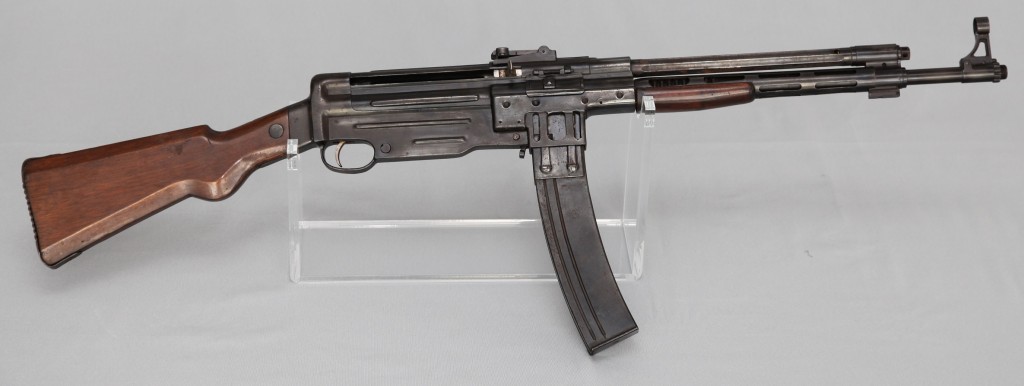
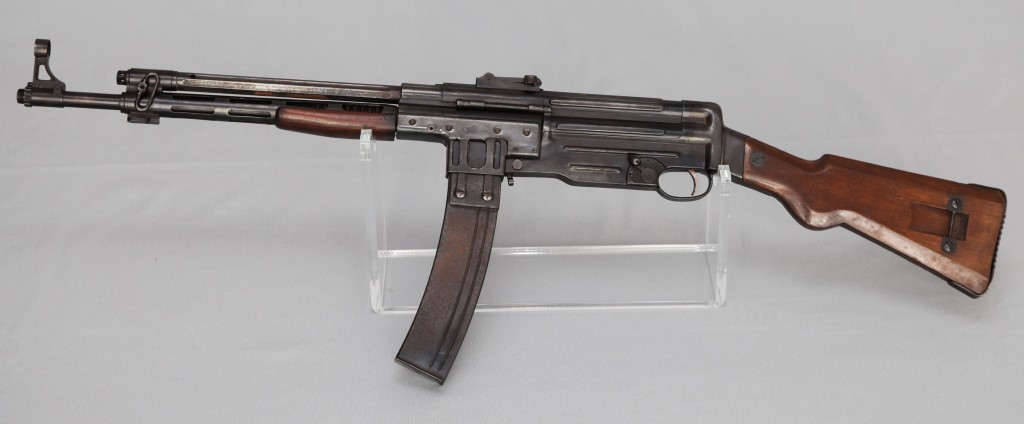
These rifles were designed by Joaquín De La Calzada-Bayo, an artillery officer posted to the La Coruna arms factory back in 1943. We don’t have any photos of their internals, but the similarities to the StG-44 are pretty obvious.


Shortly after these two models, another variant was produced, this time in the 7.92x51mm (longer) cartridge. Note that through the open ejection port of the right-side photo you can see what appears to be a bolt and carrier that are functionally duplicates of the German StG design.
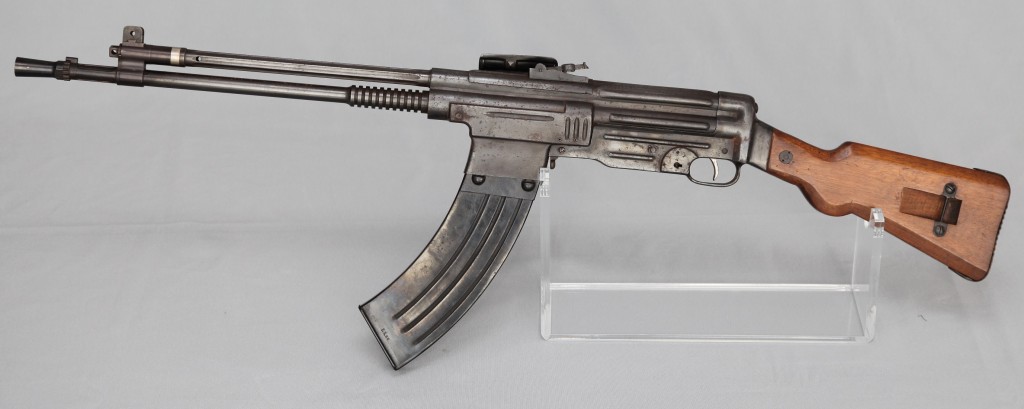
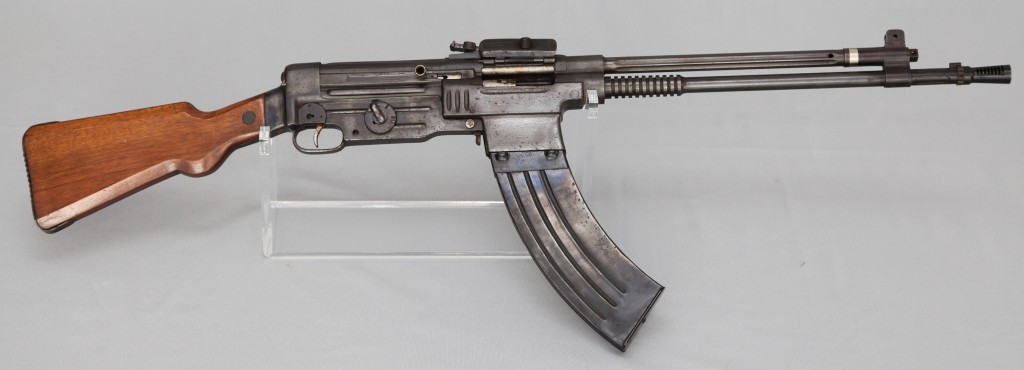




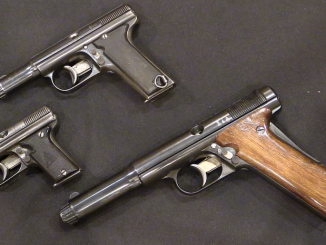
I’d like to see the 7.92×40 cartridge. I wonder how the ballistics would compare to the Wilson 7.62×40 cartridge, they developed as a competitor to the 300 Blackout.
Does anyone know whether the CETME round achieved its design aims?
I have very limited knowledge of it: very long, sharp nose, boat tail and aluminium rather than lead core.
I never heard of one…
The original CETME did not have an aluminium core as such.. it had a long aluminium tip in the front half, but the base was pretty conventional lead and copper jacket.. The aim of course was to produce a better ballistic shape in a light round by moving the c of g back and the c of p forward..
I think the later CETME rounds were full metal jacket with an internal plastic filler tip.
Great pictures of very rare weapons. Thanks for showing.
these sort of prototypes always start out with the 7.92x33mm cartridge but then go to something different.
why was the 7.92x33mm cartridge not used more ?
It probably would have been except for two factors.
First, the NATO armies weren’t interested in an intermediate cartridge at the time. They wanted a full-power round that could be used in an automatic rifle that fed reliably. This was the reasoning behind the 7.62x51mm NATO (.308 Winchester), and the reason that the British 0.280in/7mm FM2 round was rejected.
Second, on the “other side of the fence”, the Russians had their own intermediate round, the 7.62x39mm,itself based on a prototype “optimum” intermediate round developed by the Polte firm in Magdeburg, Germany to a HwA contract in 1939-40.
Mikhail Kalashnikov related that his early designs for what became the Avtomat Kalashnikov obrazets 1947g were built around first the 7.62x25mm pistol round, then the 7.9x33mm round, until he was given the specs and loaded rounds for 7.62x39mm by the Red Army ordnance bureau and told to design the new rifle around that. There is good reason to believe that the 7.62x39mm M43 round was largely the result of some creative “industrial espionage” by the USSR during its rapprochement’ with Nazi Germany prior to June 1941.
With the Russian Army standardizing on the M43 round as early as 1946 (with the SKS carbine)and the wide distribution of rifles and LMGs in that caliber to “client states” from the Fifties on, the 7.9x33mm found itself an orphan on both sides of the Iron Curtain. The West didn’t want it because it was “low-powered”; the East already had a similar and actually somewhat better round, in terms of both ballistics and feed-reliability.
Like the .41 Remington Magnum revolver cartridge of 1963-64, it was a good idea that was already more-or-less “out-evolved” when it arrived on the scene.
cheers
eon
eon, I’m sorry but can you please give exact quotes from kalashnikov memoirs that say that ” what became the Avtomat Kalashnikov obrazets 1947g were built around first the 7.62x25mm pistol round, then the 7.9x33mm round, until he was given the specs and loaded rounds for 7.62x39mm by the Red Army ordnance bureau and told to design the new rifle around that”?
Because, you know, it’s a complete nonsense.
The 7.62×25 Kalashnikov SMG of 1942 was completely unrelated by design to later AK. And the 7.62×41 intermediate round was more or less finalized by late 1943, and by late 1944 Red Army aleready tested Sudaev AS-44 assault rifle in this caliber, and by late 1945 there were quire a few experimental weapons firing this cartridge – carbines (bolt-action and semi-auto), select-fire rifles and LMGs
I am puzzled a bit . How can a projectile be “very long”
and “very light” at the same time ? The obvious answer
is the use of light-weight materials. That sounds ok
at first , but negates the request for “1000-meter effective range” . Not to mention that 1000 meters is ,
at least,a highly optimistic prospect, even for modern sniper rifles . Bryden’s statement that an aluminium tip
would produce “a better ballistic shape” further complicates matters , as it could certainly make an
aerodynamically better bullet , but not necessarily
with better ballistic performance .Furthermore, by
moving the center of gravity back ,the ballistic and aerodynamic qualities of the bullet deteriorate .
Please explain . Thanks .
You are correct that these factors are basically mutually exclusive. They are also typical of military procurement.
The client always wants as much effective range as possible, even out of an intermediate round designed to be used at ranges not much over 300 to 400 meters. In the last few decades, that has resulted in the heavyweight 70-grain bullet loads in 5.56x45mm NATO, to “stretch” the effective engagement envelope of the M16 and similar 5.56mm rifles from the original 400 meters to 700 or more.
The “justification” was the use of 5.56mm in SAWs. The “success” of this can be judged by the fact that the U.S. Army, which adopted the FN 5.56 SAW s the M249 in the 1980s, has since 2003 replaced it almost across the boards with the M240 series- an Americanized FN MAG 58/British L7 Browning gas-operated MG in 7.62x51mm NATO.
There really isn’t any practical way to make an intermediate round match a “full-bore” round in maximum effective range, unless you up-power it to the point that it has the same KE effect at both ends (impact force in front and recoil in back) that its “big brother” does. Which rather negates the whole point of an intermediate round, which is to be able to engage n enemy with aimed, controllable full-automatic fire at typical combat ranges of under 500 meters.
If you want full-power rifle range and killing power, use a full-power rifle cartridge, and accept that its going to kick harder and be harder to control in full-auto fire. Even legislatures cannot change the laws of physics.
As for the aluminum “cap” providing a better “ballistic shape” and a partly aluminum core providing more muzzle velocity due to decreasing bullet mass, this is mainly an attempt to increase the wounding effect of the bullet without violating the Geneva and Hague accords on the prohibition of expanding bullets in “civilized” warfare.
As early as the pre-WW1 era, the Italian Army (which was still thinking in terms of fighting colonial wars against “savage tribes”) was experimenting with aluminum bullet noses in their 6.5mm Mannlicher-Carcano rounds, on the principle that the aluminum would deform on impact much like lead, thereby resulting in expansion without having the prohibited exposed lead at the tip of the bullet, like a modern sporting soft-point round.
In fact, most aluminum alloys are hard enough that they rarely deform like this, unless the alloy used is so soft that it will cause feeding problems due to “battering” against the feed ramp, etc. (Much like lead, in fact.)
What an aluminum-“nosed” rifle bullet usually does do is tumble inside the body cavity, without re-stabilizing to a blunt-end-foremost configuration as a lead-cored bullet does.
In a semi-liquid or semi-solid medium, a “teardrop” with the fat end up front is the most stable shape for a streamlined, moving object. Look at the hull of a modern nuclear submarine sometime; it’s the same sort of fluid dynamics at work.
Assuming the lead core is far enough to the front that the center of gravity (Cg) is ahead of the center of pressure (Cp) (i.e., less that half the OAL of the bullet aft of the nose), the aluminum-nosed bullet will still move the Cg far enough back that once in the body cavity, it will not re-stabilize in the “teardrop” config; it will just keep tumbling. Ripping a wound channel that looks a lot like the result of the classic rifle fixed-bayonet “thrust, twist, and withdraw” maneuver.
There’s your extra wounding effect, and the reason for aluminum “noses” on military rifle bullets.
War isn’t neat, clean or pretty.
cheers
eon
Eon, it is absolutely not the case that the USA has replaced the M249 with the M240. M240 replaced first modified Brownings in tanks, then the M60 in all other uses (after 20+ years).
The USMC has replaced the M249 in the squad auto role only with the Infantry Automatic Rifle, basically an HK416 which is basically (HK groupies cover your ears) an M16. The Marines retain the M249 in the platoon LMG role. Their principal reason for replacing the M249 was to reduce weight and reload time for dismounted, patrolling Marines.
The Army still retains the M249 and carries it on patrols. The M240 (even the titanium receive M240L model) is not normally carried on patrols (there are exceptions). The M240 replaced the M60 in all roles (took longest to replace the M60D door guns in helicopters).
Principal problem with the Army’s M249 is wear and tear and age.
SOF use the Mk46 and Mk48 latter is a 7.62 version. They are less shot out than some of the grunts’ 249s.
The M27 IAR, like the HK416, have short-stroke gas piston instead of the direct impingement system of the AR-15/M16/M4. Otherwise they are very similar, which is not surprising, since the HK416 was developed to replace the M4 and retain maximum similarity. I don’t see how H&K fanboys would get offended by their favorite firearms company delivering what was requested of them, but then again fanboy behavior is not very rational…
Gents, I’m a puzzled a bit about the rifles and wonder if they’re assigned to the right cartridges. For example, the mag in the last example looks shorter than the mag in the one above it.
If you follow the link to the page in Spanish on Calzada-Bayo, it has a dimensioned drawing of the 7.92 x 51 case, which shows a very long bullet (as described in Ian’s article) but only a taper of 0.9mm over 51mm, or about 1.02º. The 7.62 x 39 mm has a taper of (depending on which drawing you like) 1.23 to 1.25 mm over 39 mm, or 1.79-1.82º. It’s not really straight like the 7.63 NATO, which has an angle of less than half a degree, but it doesn’t seem like it should produce AK/VZ-58 levels of curvature, either.
Hmm, the 7.92 x 40 (the aluminum-core round mentioned above) comes out to 1.23º. So maybe the rifles are in the right order… here is the link to that round on the same Spanish ammo data site. Lots of pictures of the rounds including cutaways and bare, unjacketed cores. Municion.org is a great site if you habla.
http://www.municion.org/7_92x40/7_92x40.htm
I mean, “shorter longitudinally” not “shorter vertically.” Just FYI. Imprecise language will be the death of me.
Thanks for that link Kevin. I was beginning to doubt my memory of the very long Al cored bullets.
I wonder how their exterior ballistic performance compares to simillar weight conventional bullets, and to the usual approx 139 to 168 grain bullets the various militaries load into 7.62 x 51mm.
Looking at the magazines again, I’m guessing that the forward most crease in the mag corresponds to the shoulder position on the case, in order to hold the cases back against recoil.
If that is the case, then the large front to back width of the mag appears to be due to the long bullets rather than the case length.
Calzada y Bayo was a real gun tinkerer, and concluded many prototipes not only of Assault rifles, but also SMGs and Semiauto Rifles. Sadly, none of them reached full production stage. His first designs known were Mosqueton (short rifle) CB 50 and CB 51. He was trying to design for Spanish Army a more modern rifle than the Fusil Mod. 43 (basically a Spanish made Mauser Kar98 in 7,92), but realised it could only be feasible in short term if it was produced using as many parts and manufacturing processes as possible in common with the actual production Mod.43. So he ended with the Semiauto “Mosqueton CB50” prototype, which was practically a Mod.43/kar98 with the M1 Garand action (gas operated, rotating bolt)in 7,92×57 Mauser, fed by standard Mauser stripper clips. “Mosqueton CB 51” was a test variant in 7,92×33.
The “Fusil de asalto” CB 50-57 series were designed after the MP/STG44, but trying to ease the manufacturing process and reducing weight, what was fully achieved. But all Calzada-y-Bayo´s efforts didn´t succeed finally, as none of his guns were ever adopted.
more infos:
http://claus.espeholt.dk/spa_kurz.html
http://www.municion.org/792/7_92x51Cb52.htm
@ Kevin R.C. O’Brien & S.N.A.L. :
Terrific links — many thanks. One quick question to one and all on FW — what do you think of the ballistic performance of the 7.92mm x 40 cartridge versus the Czech 7.62mm x 45 cartridge in the context of post-war assault rifle and assault rifle cartridge developments? I guess I’m trying to extrapolate here on a set of “what-if’s”, as in what if these two cartridges had emerged, via the vagaries of historical precedent, to become primary competitors in the Cold War era ( as did the 7.62mm x 39 and 5.45mm x 45 ), with attendant long-term impacts on the respective parent firearms developments and philosophies? Strictly a mental exercise, of course, but something that might prove interesting.
By the way, there is an excellent, well-researched article on the comparative developmental history of assault rifles and related ammunition by Anthony G. Williams on http://www.quarry.nildram.co.uk/Assault.htm. It is titled “Assault Rifles And Their Ammunition : History And Prospects”. There are some hard-to-find photographs of early prototype rifles as well as side-by-side comparisons of various rounds. The article appears to be quite current, having last been updated in April 2014.